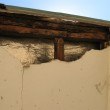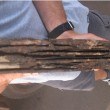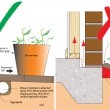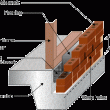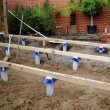B6.6 Insects: termites
Termites, or white ants, do not pose a direct health risk, however they can cause major damage to unprotected timber, which makes the house structurally unsafe and can create entry points for other pests. Talk to the housing manager about the level of termite risk as part of the design stage. Remember that some timber treatments are not guaranteed for use in northern Australia, where termites tend to be more destructive, and that treated timbers (such as CCA or copper chrome arsenate – a wood preservative) are potentially harmful to health and are not suited to internal use.
Australian regulations set out specific requirements for managing the threat of termite attack, which include:
- use of treated timbers
- physical separation techniques such as steel sub-floor structures
- additional slab reinforcement to prevent cracking and reduce access paths through cracks for termites
- mechanical barriers such as seals around all penetrations in slabs, ant caps on footings and fine stainless mesh between foundations and the structure above.
Another essential strategy is regular inspection for termite trails or mounds. It is important to provide access points in and around the house to check for termites, for example, under floors and in empty spaces.
Most surveyed houses did not report the presence of termites (91%), this was a significant improvement (11%) since 2013.
Design and Specification
Ensure
- B6.6 .1.
the house is designed according to local pest control regulations
- B6.6 .2.
ground floor walls in double storey homes are separated from upper floors with a physical barrier to prevent termites travelling undetected through the wall cavity
- B6.6 .3.
wet areas are waterproofed to prevent leaks because termites are attracted to damp timber or soil
- B6.6 .4.
houses with suspended floors have a minimum clearance of 600mm above ground to allow safe inspection and the sub-floor space is well ventilated and can easily be accessed.
Consider
For additional protection, consider:
- using termite resistant materials for the structure and wall cladding, such as masonry, steel, concrete and fibre cement sheets
- using termite resistant materials for architraves and trimming around doors, windows, skirtings and for garden bed edges
- keeping all cupboards and joinery off the floor
- using metal mesh barriers, which termites cannot cross, instead of in-ground chemical treatments
- fixing cladding, or some keys parts of the cladding, with screws rather than glue or nails for easy removal to inspect the structure behind for termites
- locating the yard taps away from the house to prevent the base of walls and surrounding ground from getting wet.
Real world examples of Solutions
- B6.6 .1.
Quality control
- a termite protection system has been installed and a copy of the warranty provided by the builder

- DESIGN COMPLETED DESIGN AND SPEC STAGE
CONSTRUCTION during construction
CONSTRUCTION at handover
TRADE TEST CONSTRUCTION end of defects period before final completion
- DESIGN COMPLETED DESIGN AND SPEC STAGE
- termite resistant materials have been used in all concealed and hard to access parts of the house, such as the sub-floor areas and roof space

- DESIGN SKETCH DESIGN STAGE
DESIGN COMPLETED DESIGN AND SPEC STAGE
CONSTRUCTION during construction
- DESIGN SKETCH DESIGN STAGE
- there is enough clearance under the floor for inspections

- DESIGN COMPLETED DESIGN AND SPEC STAGE
CONSTRUCTION during construction
- DESIGN COMPLETED DESIGN AND SPEC STAGE
- there are access hatches or panels for inspections

- DESIGN COMPLETED DESIGN AND SPEC STAGE
CONSTRUCTION during construction
CONSTRUCTION at handover
- DESIGN COMPLETED DESIGN AND SPEC STAGE
- metal flashings and ant caps on footings and walls are folded down and not torn.

- CONSTRUCTION during construction
CONSTRUCTION at handover
CONSTRUCTION end of defects period before final completion
TRADE TEST CONSTRUCTION end of defects period before final completion
- CONSTRUCTION during construction
- a termite protection system has been installed and a copy of the warranty provided by the builder
Maintenance
As part of cyclical maintenance:
- check all houses for evidence of termite trails or other termite activity

- Pest Controller
- 12 Months
- implement a program of regular termite inspections and treatments by a licensed pest management contractor, with written reports for all houses.

- Pest Controller, Housing Management
- 6 Months
- check all houses for evidence of termite trails or other termite activity
Standard And References
AS 3660.1:2014 Termite management - New building work
AS 3660.2:2017 Termite management - In and around existing buildings and structures
AS 3660.3–2014, Termite management—Assessment criteria for termite management systems.
Building out termites : an Australian manual for environmentally responsible control, Robert Verkerk, Pluto Press, 1990

